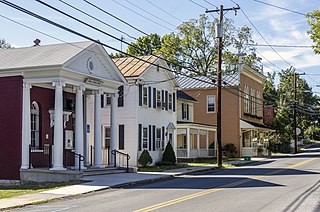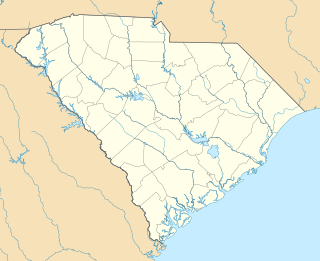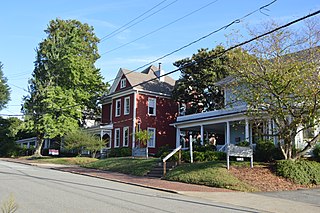
Boyce Historic District is a national historic district located at Boyce, Clarke County, Virginia. It encompasses 154 contributing buildings in the town of Boyce. They include a variety of residential, commercial, and institutional buildings dating from 1880 to the 1920s. Notable buildings include the Boyce Colored School (1885), Mount Zion Baptist Church (1910), Simpson's Store and later Boyce Grocery, former Boyce Bank now used as the Town Hall (1908), Boyce railroad station (1913), Boyce United Methodist Church (1916), and Emmanuel Chapel Episcopal Church (1916).

Latta Downtown Historic District is a national historic district located at Latta, Dillon County, South Carolina. The district encompasses 13 contributing buildings in the central business district of Latta. The buildings were erected between about 1895 and 1928. They include buildings that housed a variety of mercantile establishments such as grocery stores, drugstores, a hotel, two banks, and several dry goods stores concentrated in a block east of the railroad on Main Street. Notable buildings include the Parham Building, McMillan Building, Cox Building, and Kornblut's Department Store.

Union Street North–Cabarrus Avenue Commercial Historic District is a national historic district located at Concord, Cabarrus County, North Carolina. The district encompasses 14 contributing buildings in the central business district of Concord. It primarily includes commercial buildings in popular architectural styles including Beaux-Arts style architecture. Located in the district are the Bell and Harris-Maxwell Brothers Furniture Store (1921–1924), Yorke and Wadsworth Company Warehouse (1908–1911), Lippard and Barrier Grocery (1908–1911), Concord National Bank and Hotel Concord (1926), Star Theatre, Cannon Building and Concord Theatre, and Horton Building–Commerce and Merchants Building (1952).

Catawba Historic District is a national historic district located at Catawba, Catawba County, North Carolina. The district encompasses 48 contributing buildings and 1 contributing structure in the rural village of Catawba. It contains 19th century farmhouses and tracts of farmland with scattered outbuildings as well as village residences and a small commercial district. The district includes notable examples of Gothic Revival, Victorian, and Bungalow / American Craftsman architecture. Notable buildings include the Bagby-Danner Farmhouse, Jacob D. Little House, Town Hall, Dr, Fred Y. Long Farm, Catawba ·Baptist Church, (former) Catawba High School (1921), Quintus M. Little House, Trollinger-Sherrill House, Brawley-Lowrance House, Pitts-Little House (1924), Manson L. Wilkinson· House, Sherrill Tobacco Company Building, Catawba Drug Company, Pitts-Carpenter Building, Long and Company Store, and the Methodist Church.

Goldston Commercial Historic District is a national historic district located at Goldston, Chatham County, North Carolina. The district encompasses 15 contributing buildings in the central business district of Goldston. The buildings date from about 1890 to 1935 and includes of rows of one and two-story brick flat-roofed commercial buildings. Notable buildings include the Bynum and Paschal Warehouse, the Bynum and Paschal/Second Farmer's Union Company Store, the First Farmer's Union Store, A.J. Goldston General Store, and McLaurin Grocery Store.

Newton Downtown Historic District is a national historic district located at Newton, Catawba County, North Carolina. The district encompasses 50 contributing buildings and 5 contributing objects in the central business district of Newton. Notable buildings include the First National Bank of Catawba County, H&W Drug Company, Belk-Brumley Department Store, Alman Furniture Company Building, Catawba County Courthouse (1924), Ervin Apartments (1936), Sanitary Grocery, Freeze Drug Store, Catawba County Library (1954), Haupt Building, City Hall and Fire Station, and Eagle Building.

Riverside Historic District is a national historic district located at New Bern, Craven County, North Carolina. It encompasses 101 contributing buildings and 4 contributing sites developed as a suburban residential neighborhood in New Bern between 1894 and 1921. The district is characterized by dwellings in the Classical Revival, Queen Anne, and Bungalow / American Craftsman styles. Notable non-residential buildings include the Riverside Graded School, Riverside United Methodist Church, S. B. Parker Company Building, Sadler's store, and Hawkins Grocery Store.

Downtown Durham Historic District is a national historic district located at Durham, Durham County, North Carolina. The district encompasses 97 contributing buildings and 1 contributing structure in the central business district of Durham. The buildings primarily date from the first four decades of the 20th century and include notable examples of Colonial Revival, Italianate, and Art Deco architecture. Notable buildings include the St. Philip's Episcopal Church (1907), Trinity Methodist Episcopal Church (1880-1881), First Baptist Church (1926-1927), Durham County Courthouse (1916), Durham Auditorium, Tempest Building, National Guard Armory (1934-1937), United States Post Office (1934), Trust Building (1904), First National Bank Building (1913-1915), Mechanics and Farmers Bank (1921), Johnson Motor Company showroom (1927), Hill Building (1935), Snow Building (1933), and S. H. Kress store.

West Durham Historic District is a national historic district located at Durham, Durham County, North Carolina. The district encompasses 101 contributing buildings in a mixed industrial, commercial, and residential section of Durham. The buildings primarily date after 1892 and include notable examples of Classical Revival, Italianate, and Queen Anne architecture. Located in the district is the separately listed Erwin Cotton Mills Company Mill No. 1 Headquarters Building. Other notable buildings include Erwin Cotton Mills Co. Mill No. 4 (1909–10), Erwin Cotton Mills Co. worker's housing (1910s), Fidelity Bank (1920s), E. K. Powe School (1928), Blacknall Memorial Presbyterian Church (1922), and St. Joseph's Episcopal Church.

Trinity Historic District, also called Trinity Park, is a national historic district and residential area located near the East Campus of Duke University in Durham, North Carolina. The district encompasses 751 contributing buildings in a predominantly residential section of Durham. They were built between the 1890s and 1960 and include notable examples of Queen Anne and Bungalow / American Craftsman style architecture. Located in the district are the separately listed "Faculty Row" cottage: the Bassett House, Cranford-Wannamaker House, Crowell House, and Pegram House. Other notable buildings include the George W. Watts School (1917), Julian S. Carr Junior High School (1922), Durham High School (1923), Durham Alliance Church (1927), Trinity Presbyterian Church (1925), Great A & P Tea Company (1927-1929), Grace Lutheran Church, and the former Greek Orthodox Community Church.

Stokesdale Historic District is a national historic district located at Durham, Durham County, North Carolina. The district encompasses 227 contributing buildings, 1 contributing site, and 1 contributing structure in a historically African-American residential section of Durham. The buildings primarily date between about 1912 and 1960 and include notable examples of Queen Anne, Colonial Revival, Tudor Revival, and Bungalow / American Craftsman architecture. Notable buildings include Page's Grocery, College Inn, Covenant United Presbyterian Church (1948), and Seventh Day Adventist Church (1954).

Holly Avenue Historic District is a national historic district located at Winston-Salem, Forsyth County, North Carolina. The district encompasses 115 contributing buildings and 1 contributing site in a predominantly residential section of Winston-Salem. The buildings date between about 1885 and 1952, and include single family dwellings and apartment building. The include examples of late-19th and early-20th popular architectural styles including the Queen Anne and Italianate style. Notable buildings include the Henry Case House, James Jessup House, Henry Foltz bam (1906), Calvary Moravian Church (1923), T. R. Brann's store, and Green Front Grocery.

Bessemer City Downtown Historic District is a national historic district located at Bessemer City, Gaston County, North Carolina. It encompasses 23 contributing buildings and 10 contributing structures in the central business district of Bessemer City. The buildings were built between after 1896, and include one- and two-story commercial buildings and two large and sprawling textile mill complexes. Notable buildings include the Whetstone Cotton Mills-Huss Manufacturing Company-Algodon Manufacturing Division of Pyramid Mills, Southern Cotton Mills-Osage Manufacturing Company, Gamble Hardware, Central Drug Store, Winn-Dixie Grocery, Shulman's Department Store, and Kincaid Service Station and Pontiac Dealership.

Davidson Historic District is a national historic district located at Davidson, Mecklenburg County, North Carolina. The district encompasses 394 contributing buildings, 2 contributing sites, and 2 contributing structures in the central business district and surrounding residential neighborhoods of Davidson and campus of Davidson College. It was developed after 1837 and includes notable examples of Italianate, Greek Revival, and Gothic Revival style architecture. Located in the district are the separately listed Eumenean Hall and Philanthropic Hall. Other notable buildings include the Maxwell Chambers Building, Jackson Row (1928), Helper Hotel (1848), Johnston Grocery Store (1912), Southern Railway Depot (1897), Linden Cotton Factory (1890), Delburg Cotton Mills (1908), Davidson United Methodist Church (1908), Davidson College Presbyterian Church (1951), and Carnegie Library (1909).

Swansboro Historic District is a national historic district located at Swansboro, Onslow County, North Carolina. The district encompasses 74 contributing buildings and 1 contributing site in the central business district and surrounding residential sections of Swansboro. The district largely developed between 1890 and 1925 and includes notable examples of Federal, Greek Revival, and Bungalow / American Craftsman style architecture. Notable contributing buildings include the Jonathan Green House, Beaufort House, Bazel Hawkins House, George E. Bell House, James Elijah Parkin House (1893), William Pugh Ferrand Store, the Robert Spence McLean Store, Watson and Parkin "double store" (1910), Jim Kennedy Fish House (1930s), Baptist Church (1897), and the Emmerton School (1920s).

Carrboro Commercial Historic District is a national historic district located at Carrboro, Orange County, North Carolina. The district encompasses 12 contributing buildings in the central business district of Carrboro. The district's buildings date from about 1910 to the mid-1920s and are primarily one- and two-story brick commercial buildings. Notable buildings include the "Flatiron Building", Hearn's Grocery (1924), a Bank and Jewelry Store, the Miles Andrews House, Western Auto Store, and the building at 118-120 East Main Street.

Rowland Main Street Historic District is a national historic district located at Rowland, Robeson County, North Carolina. The district encompasses 35 contributing buildings and 1 contributing structure in the central business district of Rowland. It includes buildings built between about 1891 to 1954 in a variety of popular architectural styles including Bungalow / American Craftsman. Notable buildings include the S.L. Adams Grocery and General Store (1891), Hedgepath and Chitty Clothing and Shoe Store (1905), Kheiralla Brothers Store, Rowland Drug Company (1902), Merchants and Farmers Bank (1911), Former Fire Station, and Rolling Milling Company. Six buildings have stamped metal fronts manufactured from galvanized sheet iron by the Chattanooga Roofing and Foundry Company.

Fulton Heights Historic District is a national historic district located at Salisbury, Rowan County, North Carolina. The district encompasses 439 contributing buildings and 2 contributing structures in predominantly residential section of Salisbury. It largely developed between about 1903 and 1948, and includes notable examples of Colonial Revival and Bungalow / American Craftsman style architecture. Notable buildings include the T.A. Ludwick House, Choate-Blount House, Lauriston Hardin House, Williams-Kesler House, Lewis D. Peeler House, F.W. Kirk House, Second Reformed Presbyterian Church (1913), First Associate Reformed Presbyterian Church (1939), Calvin H. Wiley School (1916), R. L. Foil and Company Grocery (1905), the Albright Cash Store, and the Piggly Wiggly Grocery.

Laurinburg Commercial Historic District is a national historic district located at Laurinburg, Scotland County, North Carolina. The district encompasses 51 contributing buildings and 2 contributing structures in the central business district of Laurinburg. They were built between about 1893 and 1953 and include notable examples of Streamline Moderne and Art Deco architecture. Notable buildings include the Central Hotel, McDougald's Furniture Store and Funeral Parlor, Everington's Drug Store, Scotland Pharmacy (1935), U.S. Post Office (1939) designed by the Office of the Supervising Architect under Louis A. Simon and built by the Federal Works Administration, First United Methodist Church (1918), Hammond Company Building, and (former) Winn Dixie Grocery Store (1953).

West Nash Street Historic District is a national historic district located at Wilson, Wilson County, North Carolina. It encompasses 79 contributing buildings in a predominantly residential section of Wilson. The district largely developed during the 1910s and 1920s and includes notable examples of Colonial Revival and Bungalow / American Craftsman style architecture. Notable buildings include the William W. Graves House, Selby Hurt· Anderson House, Williams-Cozart House, John T. Barnes House, Graham-Woodard House, M. Douglas Aycock House (1925-1928), John D. Gold House, Boykin's Filling Station, and West End Grocery.



















